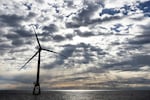
FILE - A Block Island Wind Farm turbine operates, Dec. 7, 2023, off the coast of Block Island, R.I., during a tour of the South Fork Wind farm organized by Orsted.
Julia Nikhinson / AP
Oregon’s coast is inching closer to generating renewable electricity using floating offshore wind turbines, though any construction is still years away.
On Tuesday, the U.S. Department of Interior’s Bureau of Ocean Energy Management, or BOEM, announced it has finalized an environmental assessment. The assessment looked at potential impacts from issuing leases to develop floating offshore wind in the region. BOEM is the federal agency tasked with identifying, proposing and leasing the ocean areas.
But residents and fishery groups say their requests to pause and delay these leases are falling on deaf ears. That has led one Southern Oregon county to ask voters to decide whether to actively oppose development in November.
In February, BOEM proposed two locations off the coast of Coos Bay and Brookings, totaling nearly 195,000 acres of potential wind development.
Shortly after, BOEM announced it was preparing to accept proposals to develop in those areas, but first needed to finalize the environmental assessment.
The agency has concluded, after a public comment period, that issuing leases in mid-October will have “no significant impacts to people or the environment.”
The assessment only reviews the process of issuing a lease. It does not allow construction, and does not assess environmental impacts of developing offshore wind projects.
“BOEM relies on the best available science and information for our decision-making regarding offshore wind activities,” BOEM Director Elizabeth Klein said in a statement.
The agency said it worked with state government officials, community members and tribes to gather input on how to shape its environmental analysis and is committed to ensuring any offshore wind development in “Oregon is done in a way that avoids, reduces, or mitigates potential impacts to ocean users and the marine environment.”
Offshore wind leases will give developers the right to submit proposals for BOEM to review, the agency said. And that will trigger a new environmental impact statement.
As the demand for more renewable energy increases nationwide, there is pressure to utilize ocean winds to generate more power and reduce dependence on fossil fuels. BOEM estimates Oregon’s coast could have the potential to power more than one million homes with wind energy.
But the push for floating offshore wind has driven residents, commercial fishing groups and tribes in the region to call on federal regulators to halt the leasing of the areas until there is a better understanding of environmental and cultural impacts.
Last week, Coos County commissioners unanimously voted to put a non-binding question on the November ballot asking voters whether the commissioners should oppose floating offshore wind development.
Though the vote would not have any weight on BOEM’s decision to lease the areas, it could be symbolic, said Heather Mann, executive director of Midwater Trawlers Cooperative, a commercial fishing trade association.
“I think they’re desperate to say, ‘Look, nobody’s listening and we have a responsibility to our communities, to our coastal economies, to our constituents and they are telling us no one’s listening to us,’” she said.
Mann, who worked with an informal group to develop a state roadmap defining standards for offshore wind energy, said BOEM continues to rush the process. The fishing industry and others have called for a halt numerous times. She said people have sent in hundreds of comments asking for more information regarding the environmental and coastal impacts of offshore wind, as well as what will happen to the ocean’s ecosystem.
“We’re moving to a place now where we are considering coming out and just saying no to offshore wind rather than being willing to work through a process, because that process is stalled,” she said. “BOEM is moving forward regardless, and we feel that our livelihoods, but also the ocean, is imperiled from this type of activity. So I think people are outraged at the speed with which this is moving.”
She said a full stop would allow for the remapping of the entire Oregon Coast and a look at ocean depths deeper than 1,300 meters. Mann said there is much less fishing activity beyond that point and less disruption to current activities.
“If that were to happen, we would be willing to stand down and participate in that process,” she said.
But Mann cautioned if BOEM does not slow down, Oregon could see the same potential impacts New England is experiencing now — such as a July 13 blade failure that led to thousands of fiberglass shards and pieces washing up ashore. Federal and state officials are currently working on how to safely remove the damaged blade and other remaining turbine parts from the ocean.
“It’s mind boggling that people aren’t saying hold on a minute after what just happened, we need to slow down, not speed up this process,” she said.
BOEM said it is preparing a final sale notice and inviting qualified participants for a lease auction of the proposed areas in mid-October.
